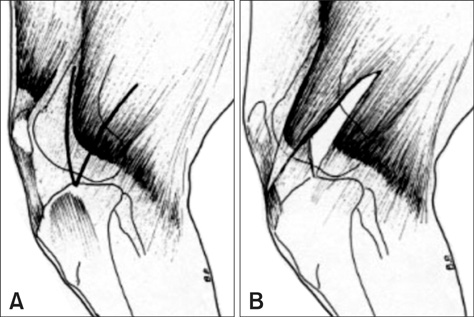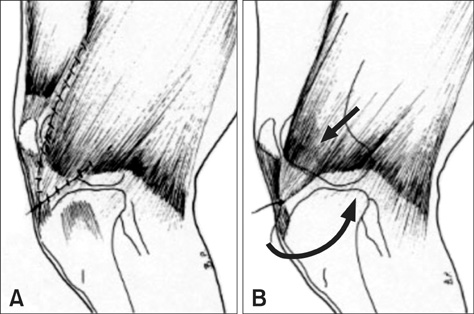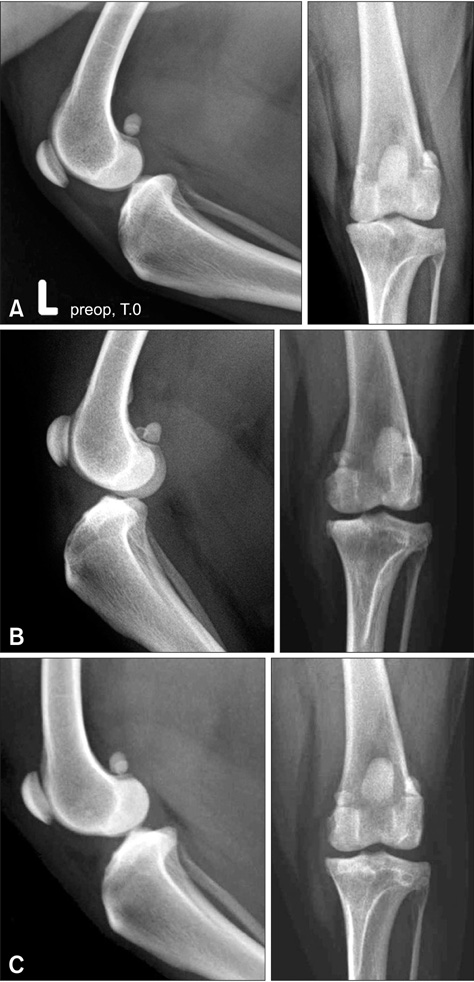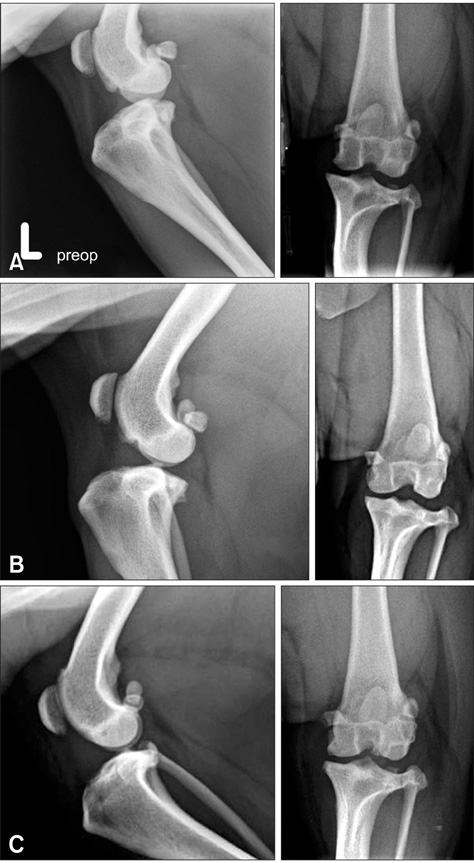J Vet Sci.
2012 Mar;13(1):93-98. 10.4142/jvs.2012.13.1.93.
Biceps femoris muscle transposition for treatment of cranial cruciate ligament rupture in small breed dogs
- Affiliations
-
- 1Department of Veterinary Medical Sciences, University of Bologna, 40064 Ozzano dell'Emilia (Bologna), Italy. roberto_tamburro@hotmail.com
- KMID: 1365008
- DOI: http://doi.org/10.4142/jvs.2012.13.1.93
Abstract
- The purpose of this study was to evaluate a new extracapsular surgical technique for the treatment of cranial cruciate ligament rupture in small breed dogs. Nine small breed dogs (seven females and two males) weighing < or = 15 kg were treated with biceps femoris muscle transposition (BFT). The duration of the BFT procedure was 20 min. Each patient underwent a standard clinical protocol and a questionnaire for the owners. Follow-up (at 1, 3, and 12 months postoperative) confirmed significant improvement in all patients, especially at 1 month postoperatively (p < 0.01) and again after complete stifle joint assessment at 3 months postoperatively. After 12 months, only two patients showed a slight increase in osteoarthritis. According to our results, BFT is a simple extracapsular surgical technique that can be used for the treatment of cranial cruciate ligament rupture in small breed dogs.
MeSH Terms
Figure
Reference
-
1. Aragon CL, Budsberg SC. Applications of evidence-based medicine: cranial cruciate ligament injury repair in the dog. Vet Surg. 2005. 34:93–98.
Article2. Arnoczky SP, Tarvin GB, Marshall JL, Saltzman B. The over the top procedure: a technique for anterior cruciate ligament substitution in the dog. J Am Anim Hosp Assoc. 1979. 15:283–290.3. Arthurs GI, Langley-Hobbs SJ. Patellar luxation as a complication of surgical intervention for the management of cranial cruciate ligament rupture in dogs. A retrospective study of 32 cases. Vet Comp Orthop Traumatol. 2007. 20:204–210.
Article4. Brown DC. Outcomes based medicine in veterinary surgery: getting hard measures of subjective outcomes. Vet Surg. 2007. 36:289–292.
Article5. Cook JL, Luther JK, Beetem J, Karnes J, Cook CR. Clinical comparison of a novel extracapsular stabilization procedure and tibial plateau leveling osteotomy for treatment of cranial cruciate ligament deficiency in dogs. Vet Surg. 2010. 39:315–323.
Article6. Curtis RJ, Delee JC, Drez DJ Jr. Reconstruction of the anterior cruciate ligament with freeze dried fascia lata allografts in dogs. A preliminary report. Am J Sports Med. 1985. 13:408–414.
Article7. Duval JM, Budsberg SC, Flo GL, Sammarco JL. Breed, sex, and body weight as risk factors for rupture of the cranial cruciate ligament in young dogs. J Am Vet Med Assoc. 1999. 215:811–814.8. Flo GL. Modification of the lateral retinacular imbrication technique for stabilizing cruciate ligament injuries. J Am Anim Hosp Assoc. 1975. 11:570–576.9. Gordon WJ, Conzemius MG, Riedesel E, Besancon MF, Evans R, Wilke V, Ritter MJ. The relationship between limb function and radiographic osteoarthrosis in dogs with stifle osteoarthrosis. Vet Surg. 2003. 32:451–454.
Article10. Hercock CA, Pinchbeck G, Giejda A, Clegg PD, Innes JF. Validation of a client-based clinical metrology instrument for the evaluation of canine elbow osteoarthritis. J Small Anim Pract. 2009. 50:266–271.
Article11. Innes JF, Barr AR. Can owners assess outcome following treatment of canine cruciate ligament deficiency? J Small Anim Pract. 1998. 39:373–378.
Article12. Jackson J, Vasseur PB, Griffey S, Walls CM, Kass PH. Pathologic changes in grossly normal menisci in dogs with rupture of the cranial cruciate ligament. J Am Vet Med Assoc. 2001. 218:1281–1284.
Article13. Jerram RM, Walker AM. Cranial cruciate ligament injury in the dog: pathophysiology, diagnosis and treatment. N Z Vet J. 2003. 51:149–158.
Article14. Johnson JM, Johnson AL. Cranial cruciate ligament rupture. Pathogenesis, diagnosis, and postoperative rehabilitation. Vet Clin North Am Small Anim Pract. 1993. 23:717–733.15. Johnston SA, McLaughlin RM, Budsberg SC. Nonsurgical management of osteoarthritis in dogs. Vet Clin North Am Small Anim Pract. 2008. 38:1449–1470.
Article16. Kim SE, Pozzi A, Kowaleski MP, Lewis DD. Tibial osteotomies for cranial cruciate ligament insufficiency in dogs. Vet Surg. 2008. 37:111–125.
Article17. Kunkel KAR, Basinger RR, Suber JT, Gerard PD. Evaluation of a transcondylar toggle system for stabilization of the cranial cruciate deficient stifle in small dogs and cats. Vet Surg. 2009. 38:975–982.
Article18. Lafaver S, Miller NA, Stubbs WP, Taylor RA, Boudrieau RJ. Tibial tuberosity advancement for stabilization of the canine cranial cruciate ligament-deficient stifle joint: surgical technique, early results, and complications in 101 dogs. Vet Surg. 2007. 36:573–586.
Article19. Laflamme D. Development and validation of a body condition score system for dogs. Canine Pract. 1997. 22:10–15.20. Marsolais GS, Dvorak G, Conzemius MG. Effects of postoperative rehabilitation on limb function after cranial cruciate ligament repair in dogs. J Am Vet Med Assoc. 2002. 220:1325–1330.
Article21. Ness MG, Abercromby RH, May C, Turner BM, Carmichael S. A survey of orthopaedic conditions in small animal veterinary practice in Britain. Vet Comp Orthop Traumatol. 1996. 9:43–52.
Article22. Piermattei DL, Flo GL, Decamp CE, editors. Handbook of Small Animal Orthopaedics and Fracture Repair. 2006. 4th ed. St. Louis: Saunders Elsevier;461–511.23. Ralphs SC, Whitney WO. Arthroscopic evaluation of menisci in dogs with cranial cruciate ligament injuries: 100 cases (1999-2000). J Am Vet Med Assoc. 2002. 221:1601–1604.
Article24. Roos EM, Lohmander LS. The knee injury and osteoarthritis outcome score (KOOS): from joint injury to osteoarthritis. Health Qual Life Outcomes. 2003. 1:64.25. Sackett DL, Rosenberg WMC, Gray JAM, Haynes RB, Richardson WS. Evidence-based medicine: what is it and what it isn't. BMJ. 1996. 312:71–72.26. Shires PK, Hulse DA, Liu W. The under-and-over fascial replacement technique for anterior cruciate ligament rupture in dogs: a retrospective study. J Am Anim Hosp Assoc. 1984. 20:69–77.27. Slocum B, Slocum TD. Tibial plateau leveling osteotomy for repair of cranial cruciate ligament rupture in the canine. Vet Clin North Am Small Anim Pract. 1993. 23:777–795.
Article28. Smith GK, Torg JS. Fibular head transposition for repair of the cruciate-deficient stifle in the dog. J Am Vet Med Assoc. 1985. 187:375–383.29. Thieman KM, Pozzi A, Ling HY, Lewis D. Comparison of contact mechanics of three meniscal repair techniques and partial meniscectomy in cadaveric dog stifles. Vet Surg. 2010. 39:355–362.
Article30. Tivers MS, Commerford EJ, Owen MR. Does a fabella-tibial suture alter the outcome for dogs with cranial cruciate ligament insufficiency undergoing arthrotomy and caudal pole medial meniscectomy? Vet Comp Orthop Traumatol. 2009. 22:283–288.
Article31. Vasseur PB. Clinical results following nonoperative management for rupture of the cranial cruciate ligament in dogs. Vet Surg. 1984. 13:243–246.
Article32. Vasseur PB, Berry CR. Progression of stifle osteoarthrosis following reconstruction of the cranial cruciate ligament in 21 dogs. J Am Anim Hosp Assoc. 1992. 28:129–136.33. Vezzoni A, Bohorquez Vanelli A, Modenato M, Dziezyc J, Devine Slocum T. Proximal tibial epiphysiodesis to reduce tibial plateau slope in young dogs with cranial cruciate ligament deficient stifle. Vet Comp Orthop Traumatol. 2008. 21:343–348.
Article34. Voss K, Imhof J, Kaestner S, Montavon PM. Force plate gait analysis at the walk and trot in dogs with low-grade hindlimb lameness. Vet Comp Orthop Traumatol. 2007. 20:299–304.
Article35. Whitehair JG, Vasseur PB, Willits NH. Epidemiology of cranial cruciate ligament rupture in dogs. J Am Vet Med Assoc. 1993. 203:1016–1019.
- Full Text Links
- Actions
-
Cited
- CITED
-
- Close
- Share
- Similar articles
-
- Feasibility of utilizing the patellar ligament angle for assessing cranial cruciate ligament rupture in dogs
- Evaluation of partial cranial cruciate ligament rupture with positive contrast computed tomographic arthrography in dogs
- Intra-articular replacement of a ruptured cranial cruciate ligament using the Mini-TightRope in the dog: a preliminary study
- Arthroscopic detection of medial meniscal injury with the use of a joint distractor in small-breed dogs
- Evaluation of an arthroscopic stifle lever for stifle joint distraction in toy breed dogs





